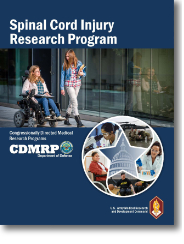Spinal Cord Injury
Vision – Advance the treatment and management of spinal cord injury and ameliorate its consequences

» Click on Image to View Program Booklet

» Click on Image to View Strategic Plan

» Click on Image to View Program Overview
Spinal cord injuries (SCIs) are complex neurotraumatic wounds affecting military Service members, their families, Veterans, and the general population. These are serious injuries with long-term consequences requiring lifelong care. It is estimated that about 300,000 individuals are living with an SCI, and this number continues to grow as over 17,000 new cases occur in the U.S. each year. For military populations, the current rate of SCI is relatively low; however, these injuries are still a major cause of medical discharge from Service. Furthermore, between 2000 and 2009, during the height of the conflicts in Iraq and Afghanistan, the rate of SCI in the military was nearly eight times that of the civilian population. As a result, the Department of Veterans Affairs is the largest single SCI care network, providing services for 10%–20% of all individuals living with an SCI in the U.S.
The Spinal Cord Injury Research Program (SCIRP) was established by Congress in fiscal year 2009 (FY09), in part as a response to the high rates of SCI observed in Warfighters returning home from duty. The Congressional intent was to establish a program to enhance the long-term care of wounded Soldiers. To this end, the SCIRP has invested over $200 million (M) into research and development efforts guided by the vision to advance the treatment and management of SCI and ameliorate its consequences relevant to injured Service members.
The SCIRP acknowledges the importance of the consumer perspective and believes that these individuals can and should be involved in all aspects of research and development. From its inception, the SCIRP has engaged people with lived SCI experience throughout the peer and programmatic review process to ensure that the needs of the SCI community are being addressed and met by SCIRP-funded research. Taking this initiative a step further, in FY19, the SCIRP began encouraging and/or requiring (as determined by program announcements) that individuals with lived SCI experience be integrated into the research team for newly funded projects. Applicants are asked to involve people with an SCI, their family members, and/or their care partners to provide ongoing advice and consultation throughout the planning and implementation of the research project. The SCIRP believes that capturing and integrating the unique perspectives and experiences of these individuals will enable better and more impactful outcomes for people living with SCI.
The SCIRP has developed a strategic plan that outlines the program's approach to addressing critical gaps in SCI research, patient care, and quality of life. Currently, the SCIRP seeks innovative and impactful research that addresses the following strategic priorities:
- Preserving and protecting spinal cord tissue at time of injury for improved neurologic outcomes
- Identifying and validating biomarkers for diagnosis, prognosis, and for evaluation of treatment efficacies
- Developing, testing, and validating promising interventions to address bowel, genitourinary, neuropathic pain, cardiopulmonary or autonomic dysfunction across the life span of people with SCI
- Investigating psychosocial issues relevant to people with SCI, their families, and/or their care partners across the life span
- Rehabilitation and regeneration-maximizing the function of the residual neural circuitry, including harnessing neuroplasticity and recovery to improve function after SCI
![]()
Congressional Appropriations
-
$397.9 million
FY09-22 -
$40 million
FY23

Funding
Summary
- 331 Awards in FY09-22
- Recent Applications Recommended for Funding

Programmatic
Panels

Peer Review Participants
Last updated Thursday, April 11, 2024

















